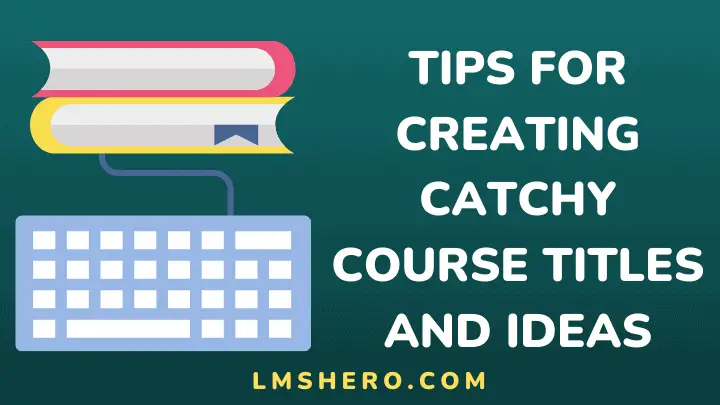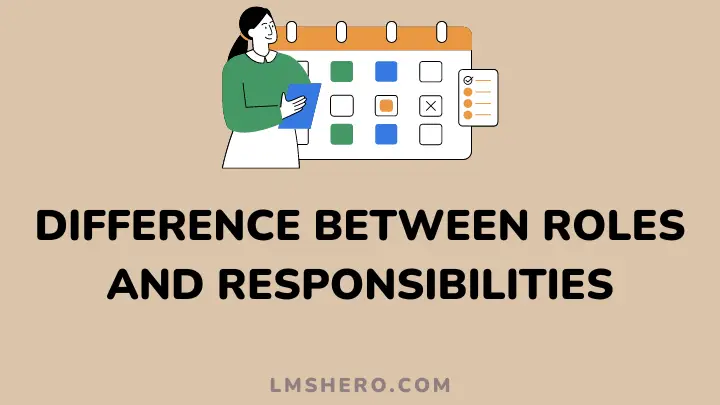One of the most important first steps in creating any meaningful course is to pick a good title. This task can be more complex than it appears at first glance. So, what can you do? You should consider familiarizing yourself with tips for crafting catchy course titles that catch students’ attention and engage them.
By now, you know that gimmicks in teaching don’t always work. It can take a lot of creativity and effort to find that “easy fix” that will have students hanging on to your every word.
Fancy course titles grab the attention of students and parents, but can also be misleading. Here are a few tips to help you create catchy course titles that accurately represent what your class teaches.
1. Know Your Audience
Knowing your student population is so important before coming up with course ideas. How do they learn? What are their interests? Who do they want to be when they grow up? It is easy to spark motivation and interest in your course by knowing your audience.
You will be able to create catchy titles for each of your courses that will resonate with your students.
In the case of students living on farms and playing several sports, you can use something like Agricultural Communications. It’s catchy and will make them realize that “agriculture” is a good course to take.
2. Grab Attention By Using Strong, Clear Words and Phrases
From the first time you put together a class syllabus, you want to create catchy titles that will get the students to show up for the course.
A great word or phrase can cause your students to investigate further and even persuade them to show up on the first day.
Furthermore, course titles are the first thing that students see when they try to register for classes. They need to be interesting or captivating so they will read on.
You should ask yourself two questions.
First, is your course title clear? Remember, you only have 10-20 seconds to get students to read further.
Second, is your course title strong? It has to draw in students and make them want to register for your class without knowing anything else about it. The words and phrases you use can help you achieve this goal.
3. Be Specific, Be creative, and Be Original
Are your course titles dull, dry, and boring? Or are they intriguing and fun to read? How you represent your course can either attract or turn off students from taking it. It will be difficult for students in your class to concentrate and complete homework assignments if the courses are boring and generic.
The more specific, creative, and original the title is, the more likely your students will spend their time completing assignments, studying for tests, and practicing skills that they can use later in life.
4. Make it Short and Sweet, But Also Memorable
Did you know that course titles have a tremendous impact on student retention and learning? Research has shown that students are more likely to remember course titles that have less than 50 characters.
Keeping your title simple will help you grab your audience’s attention faster. For example: “Internet Marketing: How to Grow Your Business Online” or “Eating for Health: Staying Fit in College.”
A course needs a proper title to help attract students. Course titles with too many words or phrases in them are hard to remember (and sound less than appealing). For the most part, a good rule of thumb is that shorter and sweeter is better.
5. Evoke a Feeling or Desire
A course title is often the first contact your class has with you and your course. It’s an opportunity to impress them, entice them, and, most importantly, make a terrific first impression… or not.
Course titles should spark interest because students learn best when they are interested in a subject. Students want to feel like someone is listening to them, that their work and thoughts are important, and that their ideas are valued.
The title should convey the feeling or “vibe” you want to give off. Readers will look at titles and decide if they want to know more information based on how it makes them feel.
6. Make the Course Title Reflect the Learning Objectives and Content
Catchy course titles are both descriptive and persuasive in different ways. There is no magic formula for writing that perfect title, but there are some general principles to follow.
The tone of a title will depend on the type of class, the audience, and what you want to teach. If you can communicate your goals and objectives clearly in your course title, students will be more likely to enroll, which means you have done your job well.
7. Make Connections To Prior Knowledge of Students
You’ve got the idea now, but do you have a catchy title yet? The right title can entice students to read the course description and perhaps even enroll.
Do these topics sound familiar? ‘Learning objectives’, ‘different types of transfer’, or ‘tips on how to create an effective study guide’? Think about what your learners already know and try combining it with your topic to create a clever tie-in.
8. Hook the Readers, Don’t Confuse Them
Don’t complicate the topic you are writing about.
Simplify it for your reader and you will more likely keep him/her interested in your writing. Have you ever noticed that business bloggers use catchy titles to get people’s attention?
They want people to click on their articles, so they make titles that grab your attention and make you want to know more.
With this in mind, your job is to give readers as much information as quickly as possible. Keep them engaged with your personality, and get them excited about what they are learning.
9. Use Popular Search Queries and Make Sure the Titles Are Search-Friendly
Teachers are often looking for new ideas and interesting ways to engage their students. Choosing a name for a course can be one of the hardest parts of course planning.
Spend some time researching popular search queries, then choose a name that matches what students are looking for.
It’s hard to believe that search engines still pull up a lot of the same results for identical queries with the only change being the addition of one word or another. This can be frustrating, and you could be missing out on tons of potential customers.
Adding some magic sauce to your title can sometimes make all the difference in funneling people to your site and keeping them there.
Use a search engine to find the keywords that are related to your course then find out which terms are most popular. Once you have a few of the most popular searches, create a catchy course title around them.
Besides, if you teach an online course, you will want it to attract students. So instead of simply choosing a title that means something to you, try one that is also search-friendly.
Use keywords that potential students would search for in their search engine. Every course title you compile should be search-friendly and easy to understand by anyone.
10. Think outside the box when necessary
Course titles are often tedious, intangible, and technical. You need to offer a title that grabs students’ attention, keeps them engaged, and encourages them to sign up.
Teaching students is a lot like fishing. You need to use the right bait to keep them thinking about signing up for your class.
From time to time, you will have a list of topics for a new course. Sometimes it’s just easier for the students when you come up with a catchy title, and sometimes it doesn’t make sense to use the jargon from your field.
Don’t be afraid to change up the usual names and think outside of the box.
If you want more ideas, try checking out college courses at your local community college or university as well as any online course platforms.
Here Are Some Ideas To Help You Create Ideal Courses
1. Purpose: What will the class be about?
In generating valid and catchy course title ideas, it is important first to be clear on the general purpose of the course.
For example, will this be an in-depth exploration of a single subject matter? Or will the course be a survey of multiple related topics? Consider your answer to this question, and then continue with the steps below.
2. Audience: Who is the course for?
Target your subject to a specific group of students and you’ll be able to deliver material that’s important to them. This can help you with writing assignments later on, as you will be able to speak specifically to their needs.
Identify the age group, grade level, and career goals of your target audience.
For example, if you’re taking a course in effective teaching strategies, it’s safe to assume that your students will be teachers. If you’re taking a course on how to raise healthy children, your students are going to be parents and teachers.
3. Learning objectives: What will the students learn?
Learning objectives are essential elements of every course. If you can express what you expect students to learn, others will understand the purpose of your course. You could have one objective or many. They just need to be stated as clearly and emphatically as possible.
A well-defined learning objective will be the basis of exam questions, discussion topics, assignments, and even lectures. So, it is very important to have a clear and specific learning objective before embarking on your course plan.
4. Course objectives and goals: What do you want them to achieve on completion?
Although all classes should have an overall goal, teachers need to have a clear, concise objective or goals in mind when planning their courses.
Without a clear course objective, it will be hard for students to understand what they need to do each day of class. This means it will be hard to manage the class.
Courses should be more than just a series of yarns strung together. Course objectives and goals help you build them as per your requirement and help create value for the audience, who would be signing up for them.
FAQs
Why does a catchy course title matter?
Whenever someone views your course, the first thing they’ll see is the title. As they browse through your platform, course titles can pique their interest and encourage them to learn more.
So you must ensure your course titles make a good first impression. You need catchy titles for that. The right title can make a big difference in getting people to notice your course.
How do you make sure my content is engaging enough to hold students’ attention?
Students don’t want to read your mind and they don’t want to read anything that sounds robotic.
Make sure your content is fun and engaging by using real-world examples that students can relate to, making it relatable. If the content is good and it is something you love, chances are other people will love it too.
What counts as “catchy” course titles?
Course titles are one of the most important features of your course, yet they’re often ignored or overlooked.
Catchy course titles are ones that clearly describe the course to students. It turns out that the same rules apply: use the most common words, keep it short, and add some spice to the mix.
Final Thoughts
Course titles are so important for marketing your course. Prospective students will judge the merits of your course just by its title and description. However, it takes more than just a catchy title to convince potential students to enroll in your course.
In this post, I have discussed what makes a great course title, and how to come up with catchy titles, and have provided you with some tips for generating course title ideas.
Take the time to choose the right title for your course, and it may be the difference between enrolling someone in your course or not.
You know how to come up with catchy titles, but are you sure what platform you will use for your course? It is no secret that there are dozens of online course platforms available, but I have taken my time to select two of the best. If you want to know which one is worth the cost, check out the article comparing Kajabi and Thinkific.
Thanks for reading.







